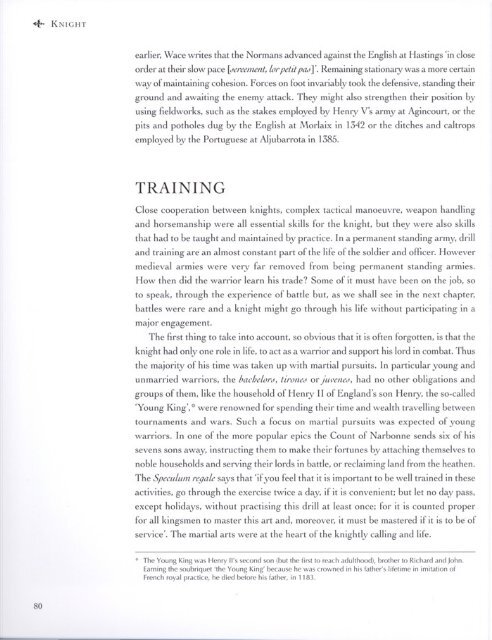Osprey - General Military - Knight - The Warrior and ... - Brego-weard
Osprey - General Military - Knight - The Warrior and ... - Brego-weard
Osprey - General Military - Knight - The Warrior and ... - Brego-weard
You also want an ePaper? Increase the reach of your titles
YUMPU automatically turns print PDFs into web optimized ePapers that Google loves.
earlier, Wace writes that the Normans advanced against the English at Hastings in close<br />
order at their slow pace \pereemerit, lor petit pcui\'. Remaining stationary was a more certain<br />
way of maintaining cohesion. Forces on foot invariably took the defensive, st<strong>and</strong>ing their<br />
ground <strong>and</strong> awaiting the enemy attack. <strong>The</strong>y might also strengthen their position by<br />
using fieldworks, such as the stakes employed by Henry V's army at Agrncourt, or the<br />
pits <strong>and</strong> potholes dug by the English at Morlaix in 1342 or the ditches <strong>and</strong> caltrops<br />
employed by the Portuguese at Aljubarrota in 1385.<br />
TRAINING<br />
Close cooperation between knights, complex tactical manoeuvre, weapon h<strong>and</strong>ling<br />
<strong>and</strong> horsemanship were all essential skills for the knight, but they were also skills<br />
that had to be taught <strong>and</strong> maintained by practice. In a permanent st<strong>and</strong>ing army, drill<br />
<strong>and</strong> training are an almost constant part of the life of the soldier <strong>and</strong> officer. However<br />
medieval armies were very far removed from being permanent st<strong>and</strong>ing armies.<br />
How then did the warrior learn his trade? Some of it must have been on the job, so<br />
to speak, through the experience of battle but, as we shall see in the next chapter,<br />
battles were rare <strong>and</strong> a knight might go through his life without participating in a<br />
major engagement.<br />
<strong>The</strong> first thing to take into account, so obvious that it is often forgotten, is that the<br />
knight had only one role in life, to act as a warrior <strong>and</strong> support his lord in combat. Thus<br />
the majority of his time was taken up with martial pursuits. In particular young <strong>and</strong><br />
unmarried warriors, the bachelors, tironed or juvened, had no other obligations <strong>and</strong><br />
groups of them, like the household of Henry II of Engl<strong>and</strong>'s son Henry, the so-called<br />
'Young King',* were renowned tor spending their time <strong>and</strong> wealth travelling between<br />
tournaments <strong>and</strong> wars. Such a focus on martral pursuits was expected of young<br />
warriors. In one of the more popular epics the Count of Narbonne sends six of his<br />
sevens sons away, instructing them to make their fortunes by attaching themselves to<br />
noble households <strong>and</strong> serving their lords in battle, or reclaiming l<strong>and</strong> from the heathen.<br />
<strong>The</strong> Speculum regale says that 'lfyou feel that it is important to be well trained in these<br />
activities, go through the exercise twice a day, if it is convenient; but let no day pass,<br />
except holidays, without practising this drill at least once; for it is counted proper<br />
for all kingsmen to master this art <strong>and</strong>, moreover, it must be mastered if it is to be of<br />
service'. <strong>The</strong> martial arts were at the heart of the knightly calling <strong>and</strong> lite.<br />
* <strong>The</strong> Young King was Henry ll's second son (but the first to reach adulthood), brother to Richard <strong>and</strong> John.<br />
Earning the soubriquet 'the Young King' because he was crowned in his father's lifetime in imitation of<br />
French royal practice, he died before his father, in 1183.







